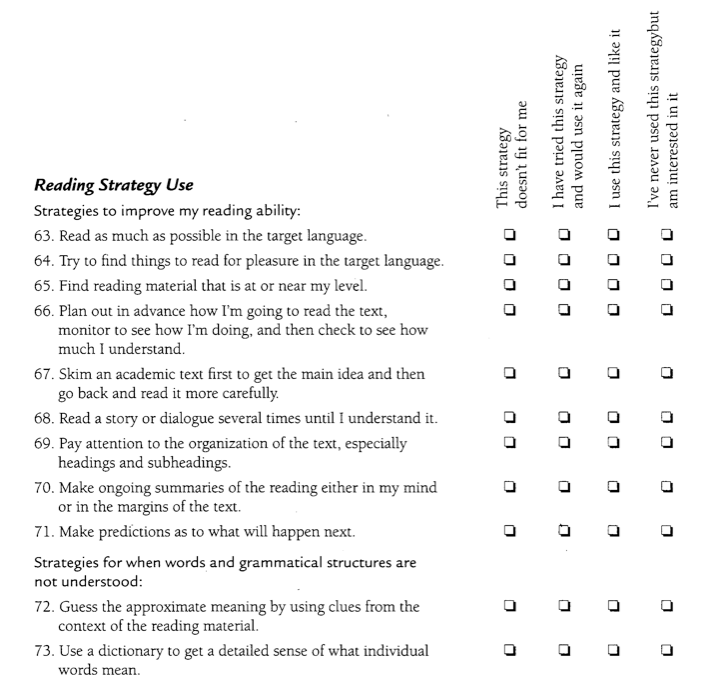View Content #17704
| Contentid | 17704 |
|---|---|
| Content Type | 3 |
| Title | A Strategic Approach to Reading |
| Body | By Julie Sykes, CASLS Director A strategic approach to effective reading expands the ways in which learners are able to approach, digest, and reflect upon the texts with which they engage. Key to meaningful reading instruction, which explicitly targets learners' reading strategies, is purposeful application of strategic activity at various stages in the reading process. In a survey of learner strategy use, Cohen, Oxford, and Chi (2002) encourage self-reflection on language use strategies especially effective for language learners. The reading section of this survey (pictured here) highlights strategies learners can use to improve their reading abilities, as well as strategies to use when they encounter unknown words or phrases.
Adopted from Cohen, Oxford, and Chi (2002), pg. 72. The survey can be used with learners in the classroom to encourage reflection about the reading process and learners' own reading strategy use. Furthermore, explicit classroom instruction facilitates the development of the use of these strategies. In an insightful discussion of reading strategies in the foreign language classroom, Mazzante and Spangler (nd), provide samples of strategy application activities across various stages of the reading process. We highlight a few examples here. (1) Annotation can be used at all three stages in the reading process – pre-reading, during reading, and post-reading. As learners read, they are asked to highlight and make notes about the elements critical to the text. This could include, for example, audience, point of view, unknown structures or words, or cause and effect. Mazzante and Spanler suggest providing an annotation system to helps learners focus on the important element. (2) Anticipation guide activities ask learners to make predictions about the topic or themes present in the reading they are about to read. This can include questions to answer, a grid to complete, or a drawing. Key to anticipating is returning to the predictions after reading to make comparisons based on new knowledge. (3) Use of information. After reading, a key to remembering the material is using in a meaningful way. This can be done through paired sharing, guessing activities, reciprocal teaching, and product creation. See A Research Toolkit of 12 Reading Strategies for the Foreign Language Classroom (http://www.psmla.net/sites/default/files/4RdgStrat%202012%20Forum.pdf) for detailed activities related to each. Key to a strategies approach is the inclusion of activities in each stage of the process to move beyond comprehension of content towards thorough interaction with any text they read. References Cohen A., Oxford, R., Chi, J. C. (2002). Language Strategy Use Survey. Minneapolis, MN: Center for Advanced Research on Language Acquisition, University of Minnesota. [In Cohen & Weaver, 2006, pp. 68-74] [note: title links to survey] Mazzante, J. and Spangler, D. (nd). A research toolkit of 12 reading strategies for the foreign language classroom. Pennsylvania State Modern Language Association Forum Publication. Available at: http://www.psmla.net/sites/default/files/4RdgStrat%202012%20Forum.pdf |
| Source | CASLS Topic of the Week |
| Inputdate | 2014-05-17 13:13:57 |
| Lastmodifieddate | 2014-05-19 02:57:49 |
| Expdate | Not set |
| Publishdate | 2014-05-19 02:15:02 |
| Displaydate | 2014-05-19 00:00:00 |
| Active | 1 |
| Emailed | 1 |
| Isarchived | 0 |

